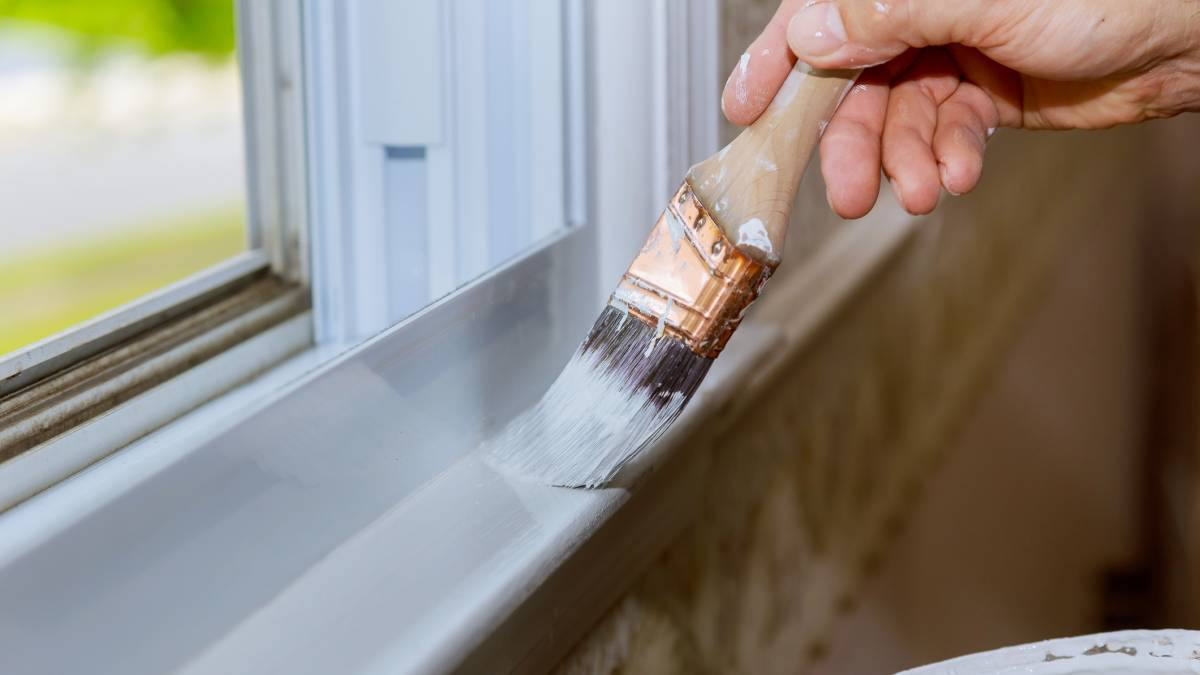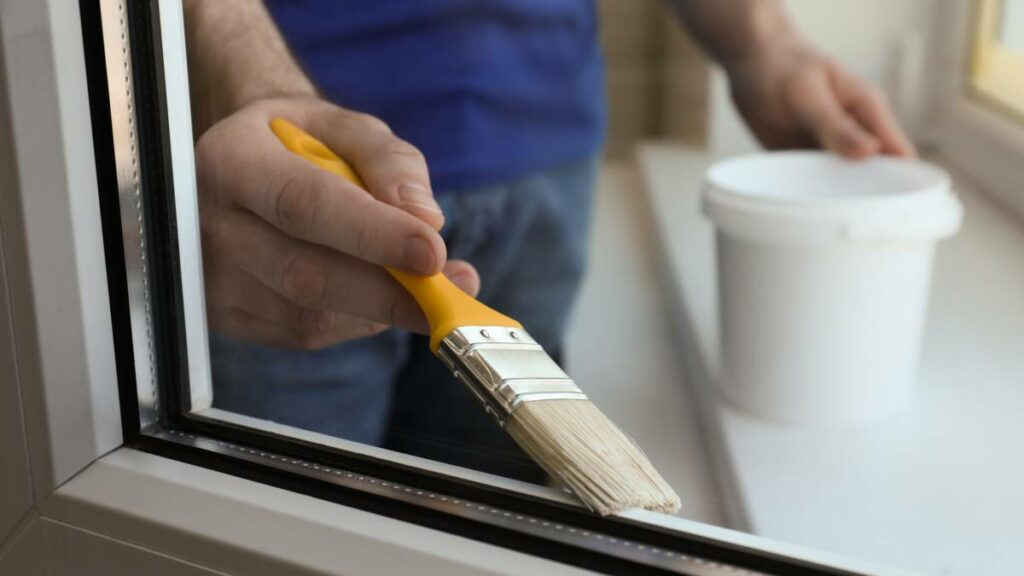
Find a local painter
- Inspiration /
- Indoor projects /
- Doors & windows /
- A guide on how to...
A guide on how to paint window frames
Freshen up your windows with new paint.
Window frames can turn yellow and weather over time. Adding a fresh coat of paint to your old window frames can give them a new lease on life. Whether you want to paint your window frames to complement your newly painted walls, it’s an easy upgrade you can do yourself.
Painting window frames can restore their glory and add a layer of durability. In this article, you’ll learn how to paint window frames for your DIY home makeover. With some tools and a few hours to spare, you can give your window frames a gorgeous and unique look.
Here’s what you’ll need to paint your window frames

- Angled sash brush – An angled sash brush is easier to control and covers tight and thin corners with ease.
- Drop cloths – Place this on your flooring to protect it from paint splatters or spills.
- Medium grit sandpaper – Used to feather the frame’s edges and remove old paint.
- Painter’s tape – Lay on the trim and any areas that don’t need painting.
- Paint stirrer – Choose a flat stirrer to mix your paint evenly.
- Primer – Get a regular oil-based primer for painting wooden window frame interiors. For metal frames, use an etch primer instead.
- Paint scraper – A paint scraper or a putty knife effectively removes loose paint.
- Razor blade – Helps remove unwanted paint splashes on your windows when applying the finishing touches later.
- Screwdriver or cordless drill – Use this to remove any window hardware before starting to paint.
- Semi-gloss paint – Use semi-gloss since they are more durable and easier to clean.
How to paint window frames like a pro
1. Clear the painting area
Use a screwdriver or a drill to detach any window hardware from your wall. Once you finish that, lay some drop cloths on the flooring below the window frames. Ensure the floors are entirely covered to prevent damage from paint spills later on.
2. Prepare your window frames

Achieving a gorgeous finish when painting window frames begins with the proper preparation.
First, remove loose paint from your window frames with a paint scraper and discard them immediately.
Next, thoroughly sand away the rest of the old paint from the edges of your window frames. Sanding minimises any chance of mould and dirt seeping into your frames, so be sure to sand rigorously. Furthermore, we want the primer to soak in the frame to ensure a lasting finish.
After removing as much old paint as possible, clean your window frames. Use a soft sponge with warm water and a mild cleaning solution. Then, thoroughly wipe your windows of any leftover dust and grime so the paint adheres to the frame. Let your frames dry completely before painting.
3. Use painter’s tape and paper towels to protect your windows
Before you start priming, use painter’s tape to mask off any surfaces you want to protect from paint marks. Professional painters often press the tape into the edge using a paint scraper or putty knife to ensure the tape fully seals the protected parts of the frame.
You can also lay a paper towel on your windows and reveals to protect it from stray paint marks. Secure the paper towels with painter’s tape and ensure the glass is completely covered. Then, apply your tape as close as possible to the window frame without blocking any edges.
4. Apply the primer

If you are painting on wood or any non-metal window frame, use a regular primer for your base coat. Start applying the primer in one section of the window frame and work your way to the next. Also, apply the primer to the window frames evenly to maximise paint adhesion. Let the primer dry afterwards.
If you are painting on metal window frames, use an etch primer as your base coat. The bonding properties of etch primers make them ideal for painting aluminium window frames. Shake the can of etch primer vigorously before spraying.
Next, hold the can at a 10-20cm distance from the window frames, then start painting. Note that it’s better to spray several coats of primer on the surface rather than one heavy coat to ensure your base coat dries evenly. Let the primer dry and thoroughly soak into the frame.
5. Start painting the frame
Prepare the paint and get started once the primer has dried. Use a paint stirrer to agitate and redistribute any solids settled in the bottom of the paint tin. Pour some paint into a separate bucket to avoid any contamination. Dip your brush in between painting strokes to maintain a wet edge.
First, paint from the top edge of the window frames and work your way down. Use long and smooth strokes to prevent paint lumps from forming on the frames. Get into those crevices and ornate details to coat them evenly.
Clean any stray paint marks with a piece of cloth. Afterwards, let the first coat dry completely. Apply more coats as necessary and ensure the paint dries completely in between coats.
6. Clear the window hardware of tape and paper towels

Before the final coat of paint has completely dried, peel off the painter’s tape and paper towels from the window frames. Use a razor blade to scrape off any last-minute paint splashes on the windows and under the tapes.
7. Return the windows back in the frame and clean the area
After the paint has completely dried, reattach the curtains, blinds, and brackets to their original places. Then, clean and store the drop rags used while painting.
Of course, you need to clean your paint tools as well. Apply the appropriate cleaning solution to your brushes and return them to your toolbox for future home makeovers.
Tips when painting your window frames
The perfect window frame paint job involves three things: proper preparation, knowledge of the usage of tools and paints, and the right painting techniques. Below are some window frame painting tips to ensure your window frames look flawless and remain durable.
Inspect your window frames first
Check the window frames, trim, and upper sash, and do a peel test to see how old the paint on your window frames is. To begin, choose a small spot on your window frames and make a small “x” mark with your razor blade. Next, apply a strip of painter’s tape on the mark and peel it off. Flakes of old paint should peel away with the tape to indicate that your window frames need new paint.
Consider the type of window frames you are painting on
Before purchasing paint, check if the window frames are wood or metal. For instance, understanding how to paint metal window frames involves looking for signs of rust. Meanwhile, wooden window frames should be inspected for signs of rot and mould. In addition, choose an etch primer for metal since its acidic properties help the paint adhere to the surface better than regular primer.
Use good ventilation and wear protective gear
Once you have prepared the window frames for painting, ensure a door is open, and a fan is operating for adequate ventilation. The paint and primer will emit fumes throughout the process, so wear a mask to protect yourself from inhaling chemicals.
Prepare the surface well
Ensure your paint adheres to the window frames by preparing the surface properly–scrape the chipped paint, smooth the surface, and clean the frame before you start. Doing this provides a smooth, attractive finish that enhances the overall look of your home and helps the paint last longer.
Dip and tap for consistent coverage
Dip your brush into the paint bucket and tap off excess paint against the walls of the bucket to avoid any drippings on your window frames.
Paint on sunny days
Sunny conditions are the ideal weather to paint, but not under direct sunlight since it can dry the paint too fast. Rainy weather can affect the paint quality due to high moisture and extend the drying time. Avoid painting late in the day to prevent dew from forming and causing unwanted paint blemishes in window frames.
Maintaining your freshly painted window frames
Taking proper care of your window frames ensures they will last a long time. Here are some valuable tips for maintaining your window frames:
- Always clean the window sill first before wiping down the frames. This will prevent any window dirt from dripping onto the frames and seeping into the substrate.
- Opt for a non-abrasive cleaning solution to safely clean all parts of your windows, as some chemicals can peel the frame away or make your window panes dull and scratchy.
- Use a lubricant on any moving parts of your window to avoid rust and undesirable creaking sounds as it wears. Apply a small amount of lubricant to the contact points of your window, such as nuts and bolts. This will add a layer of protection against harsh atmospheric conditions.
Give your window frames a flawless finish
Applying a fresh coat of paint to your window frames can spruce up your home. You can guarantee a beautiful window frame finish by following the steps and tips above. Maintain your newly painted window frames regularly to keep them in good condition for a long time.
To get the best results on your window frame painting project, don’t hesitate to contact professionals before you begin. Professional painters are dedicated to making your home redesign a success. In addition, hiring expert painters can save you time and additional costs when executing your project,
FAQs on painting window frames
Is it better to paint window frames with a brush or roller?
A brush can effectively cover narrow surfaces such as window frames. Since they have corners and detailed mouldings, an angled brush will give you more control and reach any crevices in the window frame.
On the other hand, using a roller for window frames can result in missing essential details on the window frame. Their lack of flexibility can also make it challenging to achieve a smooth finish. Instead, a roller is best used for medium to large surfaces such as walls and doors.
Can you paint aluminium windows by yourself?
Consider your aluminium window’s differences from wood. For example, aluminium is non-porous and will require a special etch primer before painting. A more thorough and consistent sanding approach is needed when painting on aluminium. So, decide if you are willing to undergo the extra effort. Perhaps it’s better to leave the job to pro painters for best results.
Can you paint a glass window for a home makeover?
Glass windows require special paint. Specialised glass paint is designed to withstand peeling and fading away. Water-based acrylic paint works best for decorating glass windows. You can even apply frosted glass spray paint on your windows to give your home a layer of privacy.
How much will your job cost?
The Oneflare Cost Guide Centre is your one-stop shop to help you set your budget; from smaller tasks to larger projects.



